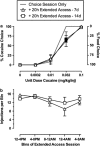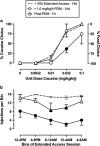Effects of phendimetrazine treatment on cocaine vs food choice and extended-access cocaine consumption in rhesus monkeys
- PMID: 23893022
- PMCID: PMC3828541
- DOI: 10.1038/npp.2013.180
Effects of phendimetrazine treatment on cocaine vs food choice and extended-access cocaine consumption in rhesus monkeys
Abstract
There is currently no Food and Drug Administration-approved pharmacotherapy for cocaine addiction. Monoamine releasers such as d-amphetamine constitute one class of candidate medications, but clinical use and acceptance are hindered by their own high-abuse liability. Phendimetrazine (PDM) is a schedule III anorectic agent that functions as both a low-potency monoamine-uptake inhibitor and as a prodrug for the monoamine-releaser phenmetrazine (PM), and it may serve as a clinically available, effective, and safer alternative to d-amphetamine. This study determined efficacy of chronic PDM to reduce cocaine self-administration by rhesus monkeys (N=4) using a novel procedure that featured both daily assessments of cocaine vs food choice (to assess medication efficacy to reallocate behavior away from cocaine choice and toward choice of an alternative reinforcer) and 20 h/day cocaine access (to allow high-cocaine intake). Continuous 21-day treatment with ramping PDM doses (days 1-7: 0.32 mg/kg/h; days 8-21: 1.0 mg/kg/h) reduced cocaine choices, increased food choices, and nearly eliminated extended-access cocaine self-administration without affecting body weight. There was a trend for plasma PDM and PM levels to correlate with efficacy to decrease cocaine choice such that the monkey with the highest plasma PDM and PM levels also demonstrated the greatest reductions in cocaine choice. These results support further consideration of PDM as a candidate anti-cocaine addiction pharmacotherapy. Moreover, PDM may represent a novel pharmacotherapeutic approach for cocaine addiction because it may simultaneously function as both a monoamine-uptake inhibitor (via the parent drug PDM) and as a monoamine releaser (via the active metabolite PM).
Figures




References
-
- Ahmed SH. Validation crisis in animal models of drug addiction: beyond non-disordered drug use toward drug addiction. Neurosci Biobehav Rev. 2010;35:172–184. - PubMed
-
- Augier E, Vouillac C, Ahmed SH. Diazepam promotes choice of abstinence in cocaine self-administering rats. Addiction Biol. 2012;17:378–391. - PubMed
Publication types
MeSH terms
Substances
Grants and funding
LinkOut - more resources
Full Text Sources
Other Literature Sources

